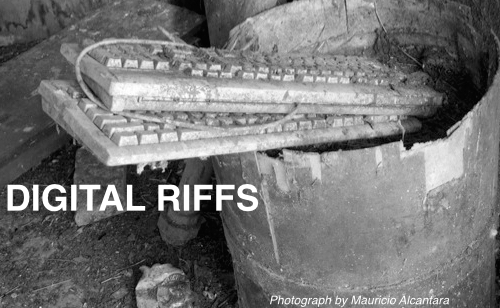I have just been reading with great enthusiasm Tim Ingold's remarkable book, Lines: a Brief History (obtained, while I was laid up with a broken leg, through the remarkable all-Wales library book reservation system at CatCymru). The starting point of Ingold's book was an anthropological investigation into the relationship between speech, song, writing and musical notation, but Ingold found that the wider history of the line - as gesture, activity, metaphor, genealogy, description, connection, ruler - is an enormously rich field of intellectual enquiry. Ingold observes at the opening of the book: 'What do walking, weaving, observing, singing, storytelling, drawing and writing have in common? The answer is that they all proceed along lines of one kind or another'. As Ingold explores the difference between different types of line - between the threads of the loom and the trace of the written letter - he opens up very rich themes which challenge many of our fundamental assumptions about the shape and nature of knowledge. For example, Ingold questions very effectively the common distinctions between writing, drawing and musical scores, suggesting that the division between them is a comparatively modern distinction, often reflecting social pressures, in just the way that artists emerged about the time of the industrial revolution as elevated and respectable figures, whereas engravers and printers became regarded as craftsmen. Ingold's suggestion that there is a close connection between weaving and writing is a particularly intriguing one.
My only disappointment with Lines is that it does not develop its rich discussion of textual technologies and shapes into the digital sphere. Ingold's book is full of suggestions for further lines of analysis and exploration on the role of the line in our digital thinking. I hope that Ingold's new book, The Life of Lines, announced for publication in 2013, will reflect on digital technologies, but in the meantime, here are just a few random thoughts prompted by his book:
- Computing provides a further illustration of the interaction between weaving and text discussed by Ingold. The idea of the programme, first developed by Ada Lovelace, was derived from the punch card technology used to power industrial looms. Ingold also stresses the assembly line as another industrial manifestation of the line, and I suppose the question this poses is the extent to which lines in computer programming reflect the analogy of the assembly line.
- Ingold's discussion of the difficulties of the concept of genealogy is particularly important, and challenging to the ways in which we think about the descent of text. I like Ingold's concluding comment here: 'The past does not tail off like a succession of dots left ever further behind. Suvh a tail is but the ghost of history, retrospectively reconstructed as a sequence of unique events. In reality, the past is with us as we press into the future' (p. 119).
- It is a commonplace of discussions of digital environments that they collapse the distinction between information objects - that books become indistinguishable from accounts or drawings or even images of material objects. Ingold argues that the distinctions between drawing and writing or between music and writing are comparatively recent - maybe only three hundred years old. In that case, is the collapse in the distinction between different types of information as radical as some commentators have suggested? Indeed, is there an argument that in fact digital environments still encapsulate and perpetuate false distinctions between sound and image which are new and which we should be trying to break down?
- Following on from this, how far does the digital world reinforce that modern distinction between drawing, writing and notation? Should we look for ways of changing the relationship between these activities in a digital environment?






